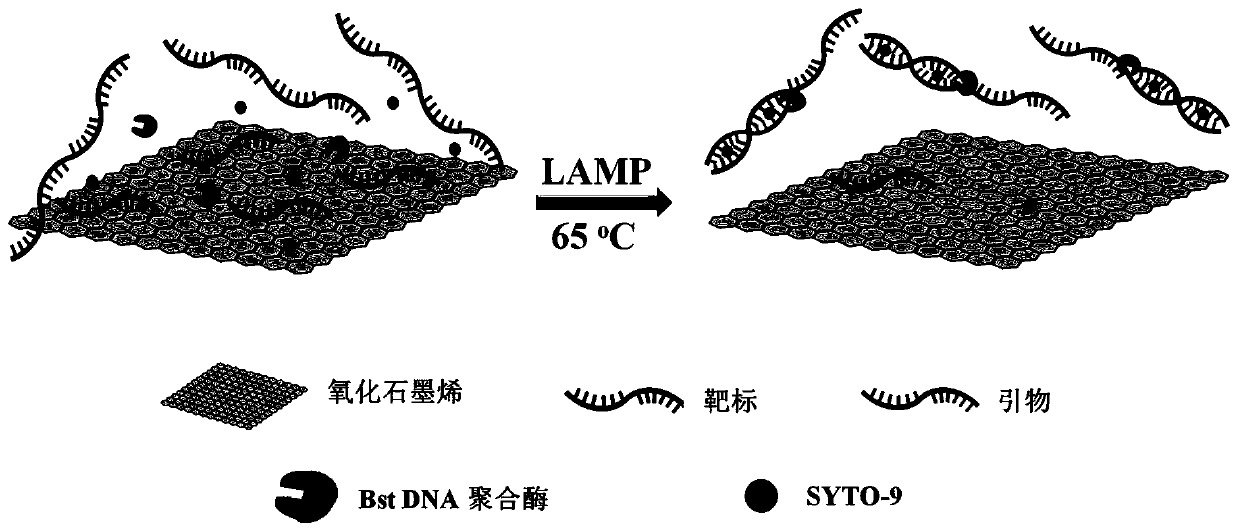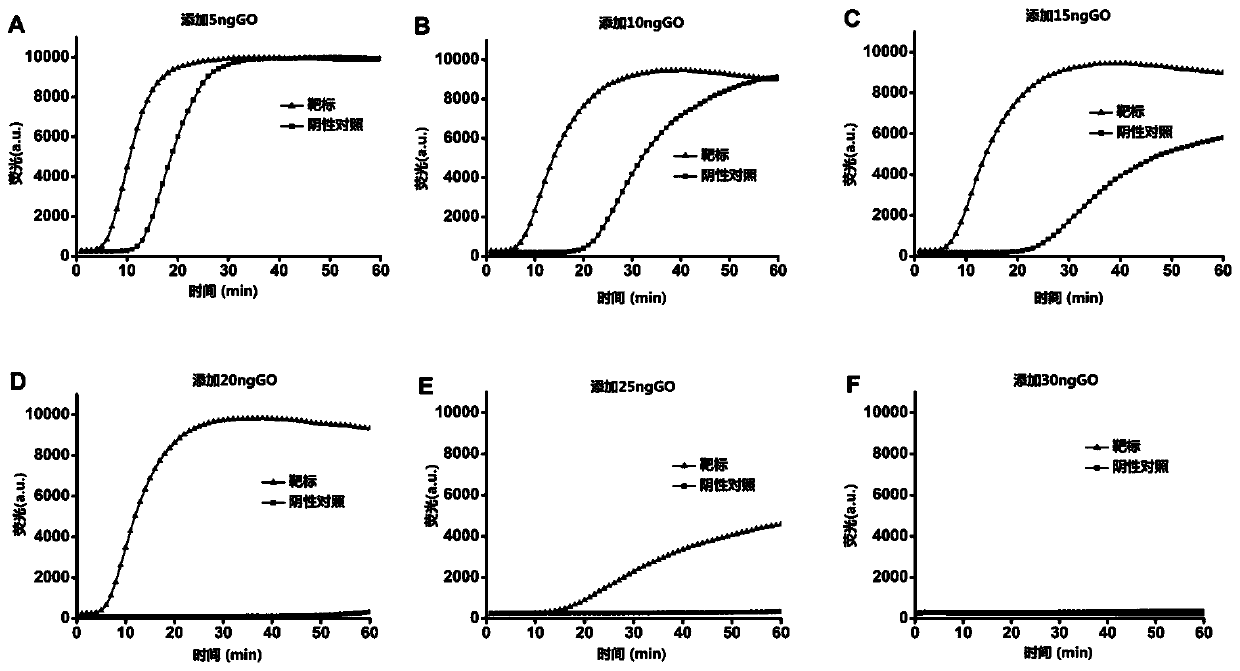Graphene oxide-containing amplification system and application of system in detection of colorectal cancer markers
An amplification system and graphene technology, applied in the field of nucleic acid amplification, can solve problems such as false positives, and achieve the effects of fast response, low cost, and small inhibitory effect
- Summary
- Abstract
- Description
- Claims
- Application Information
AI Technical Summary
Problems solved by technology
Method used
Image
Examples
Embodiment 1
[0056] Example 1 The principle that graphene oxide is used to inhibit the non-specific amplification of LAMP amplification
[0057] A major limitation of real-time fluorescent LAMP is that it is prone to non-specific amplification, and the mechanism of non-specific amplification is complex and varies with different reaction systems. Compared with PCR, the primer concentration of LAMP is high, and non-specific strand hybridization is prone to occur between primers and primers, and between primers and target sequences, so LAMP is prone to false positives. In addition, fluorescence-based LAMP methods cannot distinguish double-stranded DNA (dsDNA) structures generated by hybridization of specific amplicons from non-specific strands, resulting in false positive signals.
[0058] The non-specific mechanism of graphene oxide (GO) inhibiting LAMP is mainly based on the adsorption of GO and primers and the ability of GO to quench the background fluorescence.
[0059] Such as figure ...
Embodiment 2
[0061] Example 2 Comparison of the effects of different concentrations of graphene oxide inhibiting LAMP false positives
[0062] 2.1 Pretreatment of graphene oxide
[0063] Select graphene oxide with an average diameter of 1-4 μm (Shanghai Aladdin Biochemical Technology Co., Ltd., product number G139803-250mg), disperse it in aqueous solution, and use a 50W power ultrasonic cleaner to ultrasonically clean the graphene oxide before use. Treat for 5 minutes to disperse evenly in the solution.
[0064] 2.2 Test method and test material
[0065] In the process of optimizing the amount of GO, its addition amount was set to 5ng, 10ng, 15ng, 20ng, 25ng and 30ng, respectively. A small amount of GO was dispersed in 50% ethanol, dropped onto a copper grid with a pipette gun and dried naturally for transmission electron microscopy characterization. The characterization of GO under the transmission electron microscope is as follows: figure 2As shown, GO is lamellar and its specific ...
Embodiment 3
[0091] Example 3 Comparison of the effects of different nanomaterials for suppressing LAMP false positives
[0092] There are many nanomaterials in the prior art, including graphene oxide (GO), molybdenum disulfide (MoS 2 ) and gold nanoparticles (AuNPs) have been applied to improve the specificity of PCR. Among them, MoS 2 Binding primers and DNA-staining dyes with appropriate strength of adsorption can enhance the specificity of PCR. AuNPs interact with primers and DNA polymerase, which can enhance PCR specificity. However, there is no report on the application of the above nanomaterials in LAMP in the prior art.
[0093] We first explored the effect of these three nanomaterials in improving the specificity of the LAMP system. MoS 2 (Shanghai Aladdin Biochemical Technology Co., Ltd., product number is M196564-100mg), 5nm AuNPs (Shanghai Sophie Biomedical Co., Ltd., product number is Au010001), graphene oxide these three kinds of nanomaterials are made into aqueous solut...
PUM
| Property | Measurement | Unit |
|---|---|---|
| The average diameter | aaaaa | aaaaa |
Abstract
Description
Claims
Application Information
 Login to View More
Login to View More - R&D
- Intellectual Property
- Life Sciences
- Materials
- Tech Scout
- Unparalleled Data Quality
- Higher Quality Content
- 60% Fewer Hallucinations
Browse by: Latest US Patents, China's latest patents, Technical Efficacy Thesaurus, Application Domain, Technology Topic, Popular Technical Reports.
© 2025 PatSnap. All rights reserved.Legal|Privacy policy|Modern Slavery Act Transparency Statement|Sitemap|About US| Contact US: help@patsnap.com



